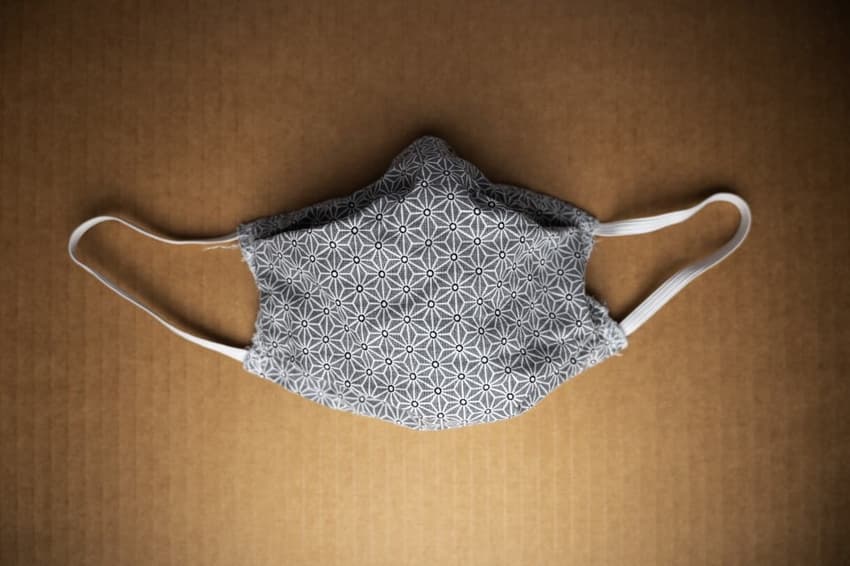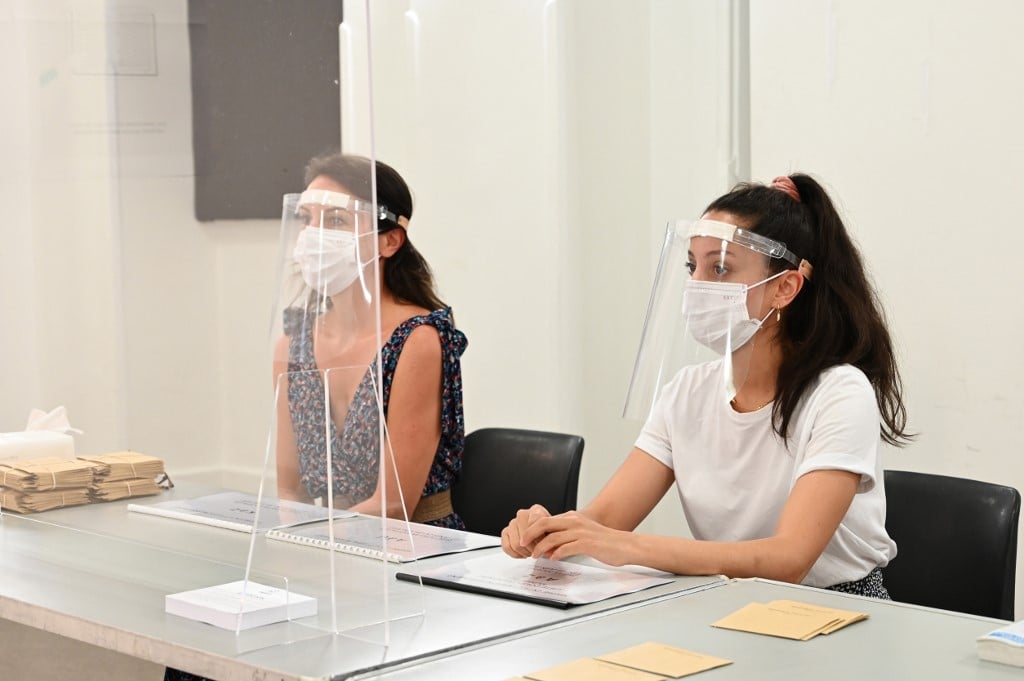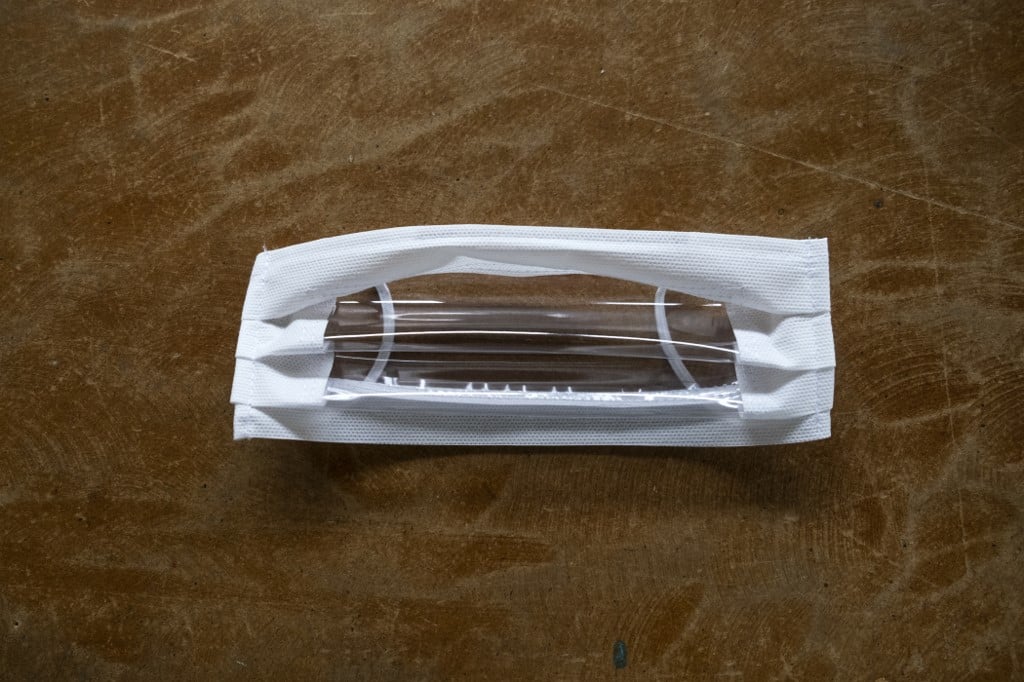France advises against fabric face masks due to new Covid variants

With new, more contagious variants of coronavirus circling health officials in France have issued updated advice warning against the wearing of fabric masks. Here is the latest guidance.
Faced with two new and relatively unfamiliar variants of the coronavirus, which were first discovered in the UK and South Africa respectively, France's health advisory council (Haute Conseil de la Santé Publique HCPS) has amended its advice to the public for wearing protective face masks.
While they have not yet published an official opinion, the council has confirmed their new position on homemade masks to French media after it was first reported in La Voix du Nord on Monday.
At this stage this is advice, not a rule.
Masks are compulsory in all indoor public spaces in France as well as on the streets in around 400 towns and cities, but the government guidance says only that a mask fully covering the nose and mouth must be worn. People caught without masks or wearing masks incorrectly face a €135 fine.
There is no distinction in the government advice between fabric or surgical masks, although individual businesses are free to impose their own conditions.
New advice
Here's what the health council has said;
"When it comes to the penetration of certain new variants. . . which are more contagious . . . the question is raised of what kind of mask to recommend to the general public," said Didier Lepelletier, co-president of the Covid-19 working group of the HCPS, during an interview with BFMTV.
Professeur Didier Lepelletier: "Le fait de porter un masque en tissu de catégorie 1 (...) est une bonne chose" pic.twitter.com/nLhIi80ZYO
— BFMTV (@BFMTV) January 18, 2021
Over the weekend, Lepelletier and the rest of the working group decided that cloth masks, preferred by many because they can be re-used, did not guarantee sufficient protection against the new Covid-19 variants.
Health Minister Olivier Véran on Tuesday morning echoed that new advice.
"Artisan masks that you make at home, with the best intentions in the world, respecting the official advice, do not necessarily offer all the necessary guarantees," he told France Inter.
.@olivierveran : "Le #masque artisanal fabriqué chez soi n'offre pas nécessairement toutes les garanties nécessaires" #le79Inter pic.twitter.com/wou2Q06136
— France Inter (@franceinter) January 19, 2021
The problem with cloth masks is that not all of them have not been officially checked and therefore their level of protection will largely depend on their fabric, thickness and the maker's craftsmanship.
Since March many small businesses in France have begun making masks that, while good for the environment and often prettily decorated, don't necessarily that the necessary thickness and layers of fabric to offer full protection.
So what mask to wear?
These are still recommendations at the stage, but the Council's recommendation is to wear a category 1 mask, rather than a category 2.
Category 2 masks are those that have been proved to filter more than 70 percent. Known as "masques du grand public" (masks for the general public) these are most cloth masks and were the ones advised to the general public last spring, but they remain common.
Category 1 masks are those that filter more than 90 percent of particles. This includes the FFP2 filter masks, the blue single-use surgical masks and certain types of fabric masks that meet specifications. The issue with fabric masks is that most are made in France, rather than imported, and a lot do not display filtration levels allowing you to know which category they fall in.
Lepelletier said everyone now should opt for category 1 masks.
He advised against purchasing FFP2 masks - the most protective ones - as these are different to wear right and lose efficiency when worn wrong. Health staff, who use these masks, are trained in how to wear them correctly.
Commenting on the new advice, several health experts also told BFMTV that it is much better to wear a fabric mask than to incorrectly wear an FFP2 mask.
What to look for when buying a mask
Figuring out whether you're buying a category 1 or category 2 mask is not quite as simple as it seems - many surgical masks are labelled Type II - but this is not the same as category 2.
You should look for filtration level first and get one that is 90 percent or more.
Almost all types of the blue surgical masks should be above 90 percent, but check the box for filtration level and/or type level - any surgical masks labelled as Type I, Type II or Type IIR filter more than 90 percent.
If you are buying surgical masks from a large chain store or multinational they should comply to international standards, but if you are buying from a smaller or independent store you should also check that the mask packaging includes information on how many masks a package contains, the name and address of the producer, the expiry date, how to stock them and instructions for use.
They should also include a mention on their norm, depending on whether they were produced in Europe (EN14682), the US (ASTM F2100-19, level 1, 2 and 3) or in China (YY 0469-2011). All of these three have been officially approved.
Fabric masks also need a label stating that they filter more than 90 percent or comply to category 1 levels. If they don't have a label - and most of the ones produced in smaller independent stores in France don't - then they cannot be guaranteed to have the correct level of filtration. Fabric masks confirming to category 1 specifications should also include how many times they can be washed before being discarded.
Home-made masks - while many people have enjoyed making their own masks, sometimes coordinated to outfits, these are now completely advised against. The HSPC says that even masks made by people who follow the Afnor specifications cannot be guaranteed to give the correct level of protection.

Volunteers wearing face shields during France's 2020 municipal elections as an extra protective measure. Photo: AFP
Face shields - the plastic face visors have never been accepted as a sufficient protection in France and you can be fined if you are wearing one of these without a proper masks underneath.

A see-through mask adapted to the needs of the hearing impaired. Photo: AFP
See-through masks - an increasing number of retailers now stock masks with transparent panels in order to help people with hearing problems to lip read. These are generally fabric masks with a plastic centre panel so the same rules apply as to other types of fabric masks.
Comments (11)
See Also
Faced with two new and relatively unfamiliar variants of the coronavirus, which were first discovered in the UK and South Africa respectively, France's health advisory council (Haute Conseil de la Santé Publique HCPS) has amended its advice to the public for wearing protective face masks.
While they have not yet published an official opinion, the council has confirmed their new position on homemade masks to French media after it was first reported in La Voix du Nord on Monday.
At this stage this is advice, not a rule.
Masks are compulsory in all indoor public spaces in France as well as on the streets in around 400 towns and cities, but the government guidance says only that a mask fully covering the nose and mouth must be worn. People caught without masks or wearing masks incorrectly face a €135 fine.
There is no distinction in the government advice between fabric or surgical masks, although individual businesses are free to impose their own conditions.
New advice
Here's what the health council has said;
"When it comes to the penetration of certain new variants. . . which are more contagious . . . the question is raised of what kind of mask to recommend to the general public," said Didier Lepelletier, co-president of the Covid-19 working group of the HCPS, during an interview with BFMTV.
Professeur Didier Lepelletier: "Le fait de porter un masque en tissu de catégorie 1 (...) est une bonne chose" pic.twitter.com/nLhIi80ZYO
— BFMTV (@BFMTV) January 18, 2021
Over the weekend, Lepelletier and the rest of the working group decided that cloth masks, preferred by many because they can be re-used, did not guarantee sufficient protection against the new Covid-19 variants.
Health Minister Olivier Véran on Tuesday morning echoed that new advice.
"Artisan masks that you make at home, with the best intentions in the world, respecting the official advice, do not necessarily offer all the necessary guarantees," he told France Inter.
.@olivierveran : "Le #masque artisanal fabriqué chez soi n'offre pas nécessairement toutes les garanties nécessaires" #le79Inter pic.twitter.com/wou2Q06136
— France Inter (@franceinter) January 19, 2021
The problem with cloth masks is that not all of them have not been officially checked and therefore their level of protection will largely depend on their fabric, thickness and the maker's craftsmanship.
Since March many small businesses in France have begun making masks that, while good for the environment and often prettily decorated, don't necessarily that the necessary thickness and layers of fabric to offer full protection.
So what mask to wear?
These are still recommendations at the stage, but the Council's recommendation is to wear a category 1 mask, rather than a category 2.
Category 2 masks are those that have been proved to filter more than 70 percent. Known as "masques du grand public" (masks for the general public) these are most cloth masks and were the ones advised to the general public last spring, but they remain common.
Category 1 masks are those that filter more than 90 percent of particles. This includes the FFP2 filter masks, the blue single-use surgical masks and certain types of fabric masks that meet specifications. The issue with fabric masks is that most are made in France, rather than imported, and a lot do not display filtration levels allowing you to know which category they fall in.
Lepelletier said everyone now should opt for category 1 masks.
He advised against purchasing FFP2 masks - the most protective ones - as these are different to wear right and lose efficiency when worn wrong. Health staff, who use these masks, are trained in how to wear them correctly.
Commenting on the new advice, several health experts also told BFMTV that it is much better to wear a fabric mask than to incorrectly wear an FFP2 mask.
What to look for when buying a mask
Figuring out whether you're buying a category 1 or category 2 mask is not quite as simple as it seems - many surgical masks are labelled Type II - but this is not the same as category 2.
You should look for filtration level first and get one that is 90 percent or more.
Almost all types of the blue surgical masks should be above 90 percent, but check the box for filtration level and/or type level - any surgical masks labelled as Type I, Type II or Type IIR filter more than 90 percent.
If you are buying surgical masks from a large chain store or multinational they should comply to international standards, but if you are buying from a smaller or independent store you should also check that the mask packaging includes information on how many masks a package contains, the name and address of the producer, the expiry date, how to stock them and instructions for use.
They should also include a mention on their norm, depending on whether they were produced in Europe (EN14682), the US (ASTM F2100-19, level 1, 2 and 3) or in China (YY 0469-2011). All of these three have been officially approved.
Fabric masks also need a label stating that they filter more than 90 percent or comply to category 1 levels. If they don't have a label - and most of the ones produced in smaller independent stores in France don't - then they cannot be guaranteed to have the correct level of filtration. Fabric masks confirming to category 1 specifications should also include how many times they can be washed before being discarded.
Home-made masks - while many people have enjoyed making their own masks, sometimes coordinated to outfits, these are now completely advised against. The HSPC says that even masks made by people who follow the Afnor specifications cannot be guaranteed to give the correct level of protection.

Volunteers wearing face shields during France's 2020 municipal elections as an extra protective measure. Photo: AFP
Face shields - the plastic face visors have never been accepted as a sufficient protection in France and you can be fined if you are wearing one of these without a proper masks underneath.

A see-through mask adapted to the needs of the hearing impaired. Photo: AFP
See-through masks - an increasing number of retailers now stock masks with transparent panels in order to help people with hearing problems to lip read. These are generally fabric masks with a plastic centre panel so the same rules apply as to other types of fabric masks.
Join the conversation in our comments section below. Share your own views and experience and if you have a question or suggestion for our journalists then email us at [email protected].
Please keep comments civil, constructive and on topic – and make sure to read our terms of use before getting involved.
Please log in here to leave a comment.